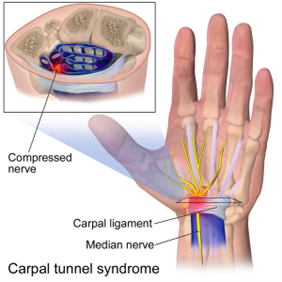Carpal Tunnel Syndrome (CTS) is a common condition that affects the hand and wrist, often causing pain, numbness, and tingling. It can make daily tasks like typing, writing, or even holding a cup challenging. But what exactly is it, and how can it be treated?
What Causes Carpal Tunnel Syndrome?
Your wrist contains a narrow passageway called the carpal tunnel, where the median nerve runs from your forearm to your hand. This nerve controls sensation and movement in your thumb and fingers (except the little finger). When this tunnel becomes narrowed or when tissues around the tunnel swell, the median nerve gets compressed. This compression is what leads to the symptoms of CTS.
Some common factors that may contribute to carpal tunnel syndrome include:
- Repetitive hand movements: People who type a lot, use a computer mouse for long hours, or do manual labor like assembly work are at higher risk.
- Medical conditions: Diabetes, rheumatoid arthritis, and even pregnancy can increase the risk of CTS.
- Injury: A wrist injury or fracture may narrow the carpal tunnel.
- Genetics: Some people are born with smaller carpal tunnels, making them more prone to CTS.
What Are the Symptoms?
CTS symptoms usually start gradually and may worsen over time. You might experience:
- Numbness or tingling: This often affects the thumb, index, middle, and part of the ring finger. It may feel like your hand is “asleep.”
- Weakness: You may have trouble gripping objects or feel clumsy when handling small items.
- Pain: The discomfort may extend from your hand up your arm to your shoulder.
Symptoms are often worse at night, and many people wake up needing to “shake out” their hands to relieve the tingling.
How Is It Treated?
Treatment depends on the severity of the symptoms. For mild to moderate cases, the following options may help:
- Rest and wrist splints: Wearing a wrist brace, especially at night, helps keep the wrist in a neutral position, reducing pressure on the median nerve.
- Activity modification: Taking frequent breaks, avoiding repetitive wrist movements, or adjusting your work setup (like using an ergonomic keyboard) can make a big difference.
- Physical therapy: Exercises to stretch and strengthen the hand and wrist may ease symptoms.
- Medications: Over-the-counter anti-inflammatory drugs or corticosteroid injections can reduce swelling and provide relief.
For severe cases or when symptoms persist despite treatment, surgery may be necessary. The procedure, called carpal tunnel release, involves cutting the ligament that presses on the median nerve to relieve the pressure.
When Should You See a doctor?
If you notice persistent numbness, tingling, or weakness in your hand, it’s important to seek medical advice. Early intervention can prevent long-term damage to the median nerve and improve your quality of life.
Carpal Tunnel Syndrome is a manageable condition, and many people find relief with simple lifestyle changes and treatment. If you think you might be experiencing CTS symptoms, don’t ignore them. Take steps to protect your hands and get the care you need.

Blausen.com staff (2014). “Medical gallery of Blausen Medical 2014”. WikiJournal of Medicine 1 (2). DOI:10.15347/wjm/2014.010. ISSN 2002-4436., CC BY 3.0 <https://creativecommons.org/licenses/by/3.0>, via Wikimedia Commons

